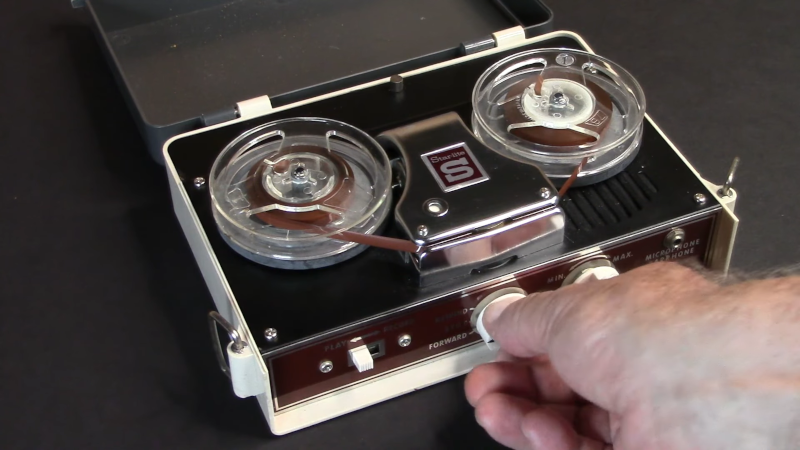When you think of a tape recorder, you might think of a cassette tape. However, [Michael Simpson] has an old Star-Lite small reel-to-reel tape machine. It isn’t a repair so much as a rework to make it work better. These cheap machines were never the best, although a $19 tape player back then was a luxury.
Part of the problem is that the design of the tape player wasn’t all that good to begin with. The motor runs off two C cells in parallel. When these were new in the 1960s, that would have meant conventional carbon-zinc batteries, so the voltage would have varied wildly. That didn’t matter, though, because the drive was directly to the tape reel, so the speed also varied based on how much tape was left on the reel.
The amplifier has four transistors. [Michael] decided to replace the capacitors on the unit. He noticed, too, that the volume control is in line with the microphone when recording, so even though the recording was supposedly in need of repair, it turned out to be simply a case of the volume control being turned down. Pretty impressive for a six-decade-old piece of consumer electronics.
The capacitor change-out was simple enough. Some cleaning and lubing was also in order. Did it help? You’ll have to listen and decide for yourself.
So, no real repair was in the works, but it is an interesting look back at an iconic piece of consumer tech. Tape recorders like this were an early form of social media. No kidding. If you’d rather not buy a tape recorder, you could roll your own.
















That recorder would be my age.
But I do remember when the reel-to-reel recorder was the sign of an awesome home sound system.
“This tape will self-destruct in five seconds”
There are videos on YouTube about the tape recorders used in the Mission: Impossible TV series, a lot of them looked like this.
Exactly what I was thinking when I saw it.
Beat me to it. I was thinking “Good morning Mr. Phelps…”
Be careful with these cheap recorders. My Dad had one with a permanent magnet erase head that left the tape magnetized in a way that would magnetize the playback head if you tried to play the tape on another tape deck.
I’ve never seen capacitors fail high. Maybe they were just loosely spec’d??
Also, if I really wanted to check them I’d check the ESR, not just the capacitance.
I am a fan of Reel to Reel tape recorder. I have two Akia Reel decks from the 70’s. Lovely machines they are.
Akai?
Some time in the early 60s, when I was around five years old, I received a compact reel-to-reel recorder similar to this one as a gift from my grandmother. (It was a little higher quality, at least; it had a capstan drive and I don’t remember there being any problems with it maintaining a constant tape speed.) She had the same model, and the idea was that we would record tapes and send them to each other. I think that lasted a couple of months…. I did continue to use the recorder for assorted musical experiments at least through high school.
Was at an estate sale this past week and they were 2 of these units for sale. I was not interested in them but I have 5 bigger units a couple of TEAC units, a SONY and a AKAI
Great video. I looked in my equipment archives and there it is, a Star-Lite Tape-O-Matic TP-700! I will check it out. Wonder if it has advanced features such as a capstan tape drive and fast forward capability
I had that exact same Star-Lite tape recorder in the 1960s. It worked great until one day in the 1970s when it just died.